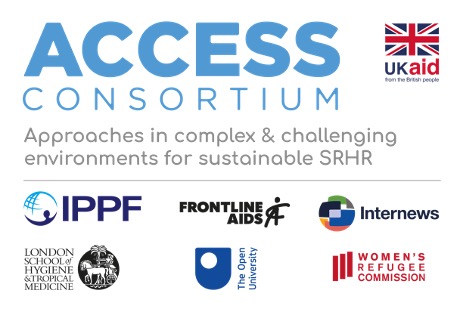You are here
- Home
- Research
- Projects
- ACCESS - Approaches in Complex and Challenging Environments for Sustainable SRHR
- Blogs and resources
- Online comprehensive sexuality education: What is known and what is needed?
Online comprehensive sexuality education: What is known and what is needed?
Authors:
Amy Dean
Independent Researcher
Dr Rebecca L. Jones
Senior Lecturer in Health, The Open University, UK
Dr Nashwa Ismail
Lecturer in Education, Durham University
Date: November 2021

This article is one of three linked discussions of Comprehensive Sexuality Education (CSE) produced as part of the scoping work of the ACCESS consortium by the Open University team. The other articles focus on CSE for out-of-school refugee youth and Effective CSE in general.
There is currently considerable interest in online forms of Comprehensive Sexuality Education (CSE) for young people. This short overview explores the benefits and challenges of online learning resources for CSE and makes recommendations for future developments. We use the term ‘online’ for brevity but also include computer-based but offline learning resources, such as content that can be downloaded to phones when connected to the internet and used later, and DVDs. We focus particularly on CSE in Global Southern contexts.

© Grafvision | Dreamstime
Potential benefits
- Anonymous
- Private
- Young people often like online spaces
- Interactive
- Portable
- Accessible at any time
- More easily adapted than printed resources
- Cost effective, especially at scale
- Ability to track data to measure reach and engagement
Benefits of online CSE
Adolescents typically trust online sources (Marques et al., 2015) and globally young people’s access to online resources through mobile phones is ever increasing (UNICEF, 2019), although boys and young men have significantly greater access than girls and young women (Waldman and Amazon-Brown, 2017). Providers of CSE value the relative ease of adaption of online resources to suit diverse audiences (Muller et al., 2017, Sun et al., 2017).
Online CSE resources can enable young people to assemble information that is not readily available to them from other sources, such as school-based CSE or family members and friends. This can provide SRHR information that fills a gap that is created by the censoring of information elsewhere (Waldman and Amazon-Brown, 2017). It has the potential to create a space free from judgement or taboo, that is not focused on culturally acceptable sexuality education, which often omits contested topics such as abortion, sexual pleasure, and homosexuality (Wekesah et al., 2019). Online CSE resources may be particularly useful for young people who are not in school and are particularly vulnerable to adverse SRHR outcomes, such as many refugees (UNESCO, 2021). It can also be particularly valuable for young people who identify as part of the LGBTQI+ community, and young women and girls who face barriers to accessing services due to cultural norms and restrictions to their mobility (UNICEF, 2020).
Additional benefits to online CSE are that information can be accessed privately and anonymously at any time (connectivity and access permitting), although see ‘Challenges of online CSE’ below for some limitations to this. Online CSE also enables young people to search for a specific question or browse websites or apps to engage with information more broadly (UNICEF, 2019). One study explored the use of a mobile application ‘Tune me’ across eight sub-Saharan African countries and found that it provided an important source of SRHR information, especially where traditional CSE was lacking (Rogers et al., 2020).
 Websites can provide an interactive space where young people can discuss experiences and ask questions around sex, sexuality, and relationships anonymously (Bay-Cheng, 2005, Muller et al., 2017). A comparative study on two websites found that, contrary to some CSE providers’ fears, websites without adults monitoring the content did not necessarily result in bullying, pressure to engage in sexual activity or other negative experiences. Rather, unmonitored websites can create supportive online spaces and allow for more content to be explored beyond the scope of usual CSE topics, for example discussions around body hair (Bay-Cheng, 2005). This study found that unmonitored online forums can enhance young people’s critical thinking skills as they curated information together: they questioned and challenged information posted by peers on the site, rather than just accepting it, as they might have done with information supplied or verified by adults.
Websites can provide an interactive space where young people can discuss experiences and ask questions around sex, sexuality, and relationships anonymously (Bay-Cheng, 2005, Muller et al., 2017). A comparative study on two websites found that, contrary to some CSE providers’ fears, websites without adults monitoring the content did not necessarily result in bullying, pressure to engage in sexual activity or other negative experiences. Rather, unmonitored websites can create supportive online spaces and allow for more content to be explored beyond the scope of usual CSE topics, for example discussions around body hair (Bay-Cheng, 2005). This study found that unmonitored online forums can enhance young people’s critical thinking skills as they curated information together: they questioned and challenged information posted by peers on the site, rather than just accepting it, as they might have done with information supplied or verified by adults.
Online CSE can enable more active forms of learning. One study with Chinese college students found that the use of interactive posts, generated higher engagement from the young people and led to changed attitudes to contraceptive and condom use (Sun et al., 2017). The use of ‘like’ and ‘dislike’ features on posts allows young people to quickly and simply report what they found helpful or informative and indicate what they dislike or find unhelpful (Waldman & Amazon-Brown, 2017).
Chatbots can provide answers to frequently asked questions in a way that feels particularly anonymous and private, and developments in artificial intelligence make them increasingly useable UNICEF (2020a). One study found that chatbots provided useful information on sexually transmitted infections, as well as being able to signpost users to services, although some users distrusted the accuracy of information gained from a chatbot (Nadarzynski et al., 2021). Chatbots can also be used to report abuse and to offer users support and information to safeguard them (UNICEF, 2020a).
Games are often thought to appeal to young people, as they are attractive, confidential, and convenient. Young people are already exposed to the digital game’s environment, thus sexual health matters within the form of a game can be an easier and more motivating method of learning. One study found significantly improved learning, motivation, engagement and attitudinal change among Tanzanian school students using gamified and game-based CSE, compared to those who received traditional CSE (Haruna et al., 2018) and other studies have had similar findings (Chu et al., 2015, Jiang and Ha, 2020, Kwan et al., 2015).
Online platforms usually enable data to be collected automatically on how many people use the resource and which parts of the resource are most popular. This makes it possible for providers to have a measure of reach (numbers of users and approximate geographic location) and engagement (which parts of the resource are accessed), and to then use this information to update the resource to best meet the needs of young people (UNICEF, 2019, UNICEF, 2020a, Waldman and Amazon-Brown, 2017).
As with any CSE intervention, the effectiveness of online CSE varies according to context (Rijsdijk et al., 2011), and changes in attitudes and knowledge are more commonly found than changes of behaviour because individuals do not always have the power or resources to change sexual behaviours.
Potential Challenges
- Access to internet and electricity
- Access to devices (mobile, tablets, PCs)
- Digital gender divide makes it much harder to reach girls and young women
- Forums may need moderating
- Chatbots do not always work well
- Not all online sex educational resources adhere to CSE principles: some are abstinence-based
- Young people may encounter distressing and exploitative content
- CSE resources can be censored due to blanket policies restricting sexually explicit materials.
Challenges of online CSE
Not all young people have access to their own devices and many share with family, friends, or neighbours. Girls and young women are significantly less likely to have their own devices than boys and young men (Waldman and Amazon-Brown, 2017) especially in South Asia. This means that they are unable to download applications without others being aware, and are more reliant on adult guidance and permission to access information (UNICEF, 2020a).
Although online CSE is usually much more private and anonymous than face-to-face CSE, young people may not understand their ‘digital footprint’ well, and so may overestimate the degree of privacy and anonymity that they actually have. For example, posts to a closed WhatsApp group may be shared elsewhere by another group member and online platforms like Facebook routinely collect user data to measure their reach.
There are concerns that any online space focused on SRHR topics has the potential to lead to online bullying, inappropriate exposure to sexual images, sexual solicitation, discriminatory messages and dangerous behaviours being advocated (UNICEF, 2019). Providing moderators for such sites can create safe educational spaces but is typically demanding of staff/volunteer time and makes it more difficult for young people to feel that they own the space (Bay-Cheng, 2005).
Chatbots may not be able to respond appropriately if questions are asked outside of their programmed response and some users may not initially realise that they are not talking to a real person, which can be distressing. Some users distrust the accuracy of information gained from a chatbot (Nadarzynski et al., 2021). Chatbots also may not always respond appropriately to ‘at-risk’ messages and are therefore unable to safeguard disclosures of abuse, violence or suicidal ideations (UNICEF, 2020b). To overcome this some chatbots are programmed to ask if the users would like to speak to a real person if high risk words are used, along with links to local helpline numbers and resources (UNICEF, 2020b).
Just like face-to-face CSE, online sources of information about sex may not adhere to CSE principles, instead using fear-based language to persuade young people to delay sexual intercourse as well as reinforcing gender norms that portray young women as the gatekeepers of sexual behaviour, whilst also normalising pleasure for men (Marques et al., 2015) Some online CSE has been shown to portray negative gendered stereotypes, reinforcing hegemonic masculinity by portraying boys and men as overly sexual, aggressive, and dominating (Rogers et al., 2020).
Young people accessing CSE online are typically doing so with less adult supervision than face-to-face CSE, and this may mean that they accidentally encounter inappropriate content such as pornographic or violent images whilst searching for educational sites (UNICEF, 2019).
Large internet service providers, such as Facebook and Google, restrict information focused on nudity, cleavage, and sexually explicit content and this can mean that CSE resources are also censored. Many schools, colleges and workplaces also limit which websites can be accessed, often excluding all sexuality-related content, including CSE resources (Muller et al., 2017).
Online trends and favoured platforms change rapidly and vary according to users’ ages, genders, locations, access to connectivity etc. This makes it challenging to produce resources which use currently favoured tools among the target group. Developing CSE-focused computer games is relatively expensive and such games often date particularly quickly because of their typically slower production timescales compared to commercial games.
Recommendations for future developments
- Online CSE should be used where it carries clear benefits. For example, reaching hard-to-reach groups, providing specialist information, connecting geographically dispersed communities, covering topics where anonymity and privacy are especially important and providing resources at scale.
- Be aware of connectivity issues, if this is an issue in the context, and design accordingly. For example, text-based resources require much less bandwidth than video-based content.
- Be aware of which platforms the target group uses and respond to changes in these as quickly as possible.
- Simpler computer games that do not attempt to mimic commercial games may be more effective if resources are limited.
- Developing more complex online CSE resources may involve more upfront costs than face-to-face CSE. Savings are likely to come from scaling-up and increased reach.
- While there is great enthusiasm for online CSE within the sector, relatively little is still known about how such resources are used and how effective they are. More studies of use and effectiveness would be very valuable.